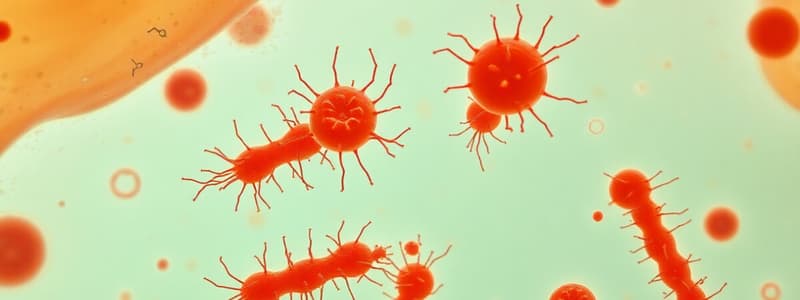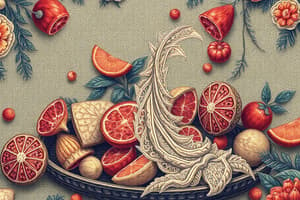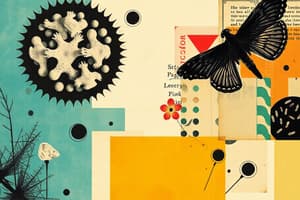Podcast
Questions and Answers
What process makes a food product undesirable for consumption?
What process makes a food product undesirable for consumption?
- Food fermentation
- Food preservation
- Food spoilage (correct)
- Food enrichment
Which of the following is NOT a major cause of food spoilage?
Which of the following is NOT a major cause of food spoilage?
- Insect damage
- Microorganism activity
- Refrigeration (correct)
- Chemical reactions
What type of spoilage occurs due to the activity of enzymes?
What type of spoilage occurs due to the activity of enzymes?
- Physical spoilage
- Microbial spoilage
- Chemical spoilage
- Enzymatic spoilage (correct)
Which change is associated with spoiled oils?
Which change is associated with spoiled oils?
Which of the following factors can contribute to the physical damage of food?
Which of the following factors can contribute to the physical damage of food?
What type of change might you observe in a banana after long storage?
What type of change might you observe in a banana after long storage?
Which type of reaction can cause rancidity in food?
Which type of reaction can cause rancidity in food?
What role do microorganisms play in food spoilage?
What role do microorganisms play in food spoilage?
What is the main consequence of microbial growth in food?
What is the main consequence of microbial growth in food?
Which microbes primarily affect carbohydrates in food?
Which microbes primarily affect carbohydrates in food?
At what pH level are foods primarily susceptible to spoilage by molds and yeasts?
At what pH level are foods primarily susceptible to spoilage by molds and yeasts?
What minimum water activity (aw) is required for most microbes to grow?
What minimum water activity (aw) is required for most microbes to grow?
Which temperature range is most suitable for microbial growth?
Which temperature range is most suitable for microbial growth?
What is the role of oxygen in the growth of certain molds?
What is the role of oxygen in the growth of certain molds?
What is a characteristic of perishable foods?
What is a characteristic of perishable foods?
What is one way that natural coverings protect food from microbial growth?
What is one way that natural coverings protect food from microbial growth?
What role do phenolases and polyphenol oxidases play in food spoilage?
What role do phenolases and polyphenol oxidases play in food spoilage?
Which conditions are most unfavorable for insect breeding?
Which conditions are most unfavorable for insect breeding?
Which chemical reaction is primarily responsible for the formation of black brown pigments in food?
Which chemical reaction is primarily responsible for the formation of black brown pigments in food?
What factor is NOT typically associated with lipid oxidation in food spoilage?
What factor is NOT typically associated with lipid oxidation in food spoilage?
How does freezing contribute to food spoilage?
How does freezing contribute to food spoilage?
What is a common manifestation of microbial activity in spoiled food?
What is a common manifestation of microbial activity in spoiled food?
Which statement about chlorophyll degradation in fruits and vegetables is true?
Which statement about chlorophyll degradation in fruits and vegetables is true?
What type of spoilage process is associated with the interaction of anthocyanins with metals?
What type of spoilage process is associated with the interaction of anthocyanins with metals?
Flashcards
What is food spoilage?
What is food spoilage?
A process that alters a food product, making it undesirable or unfit for consumption.
Microbial Spoilage
Microbial Spoilage
Microorganisms like bacteria, yeast, and molds can grow and multiply in food, causing spoilage.
Enzymatic Spoilage
Enzymatic Spoilage
Enzymes naturally present in food can break down its components, leading to spoilage.
Physical Damage
Physical Damage
Signup and view all the flashcards
Oxygen Exposure
Oxygen Exposure
Signup and view all the flashcards
Temperature Abuse
Temperature Abuse
Signup and view all the flashcards
Moisture Loss
Moisture Loss
Signup and view all the flashcards
Chemical Reactions
Chemical Reactions
Signup and view all the flashcards
Endogenous Enzymes
Endogenous Enzymes
Signup and view all the flashcards
Lipid Oxidation
Lipid Oxidation
Signup and view all the flashcards
Maillard Reaction
Maillard Reaction
Signup and view all the flashcards
Caramelization
Caramelization
Signup and view all the flashcards
Exogenous Microorganisms
Exogenous Microorganisms
Signup and view all the flashcards
Chlorophyll Degradation
Chlorophyll Degradation
Signup and view all the flashcards
Metal-Pigment Interactions
Metal-Pigment Interactions
Signup and view all the flashcards
Microbial Activity
Microbial Activity
Signup and view all the flashcards
Water Activity (aw)
Water Activity (aw)
Signup and view all the flashcards
Acidity and Food Spoilage
Acidity and Food Spoilage
Signup and view all the flashcards
Nutrient Utilization by Microbes
Nutrient Utilization by Microbes
Signup and view all the flashcards
Temperature and Microbial Growth
Temperature and Microbial Growth
Signup and view all the flashcards
Oxygen Availability and Microbial Growth
Oxygen Availability and Microbial Growth
Signup and view all the flashcards
Inhibitory Substances
Inhibitory Substances
Signup and view all the flashcards
Biological Structure and Microbial Contamination
Biological Structure and Microbial Contamination
Signup and view all the flashcards
Perishable Foods
Perishable Foods
Signup and view all the flashcards
Study Notes
Food Spoilage: Types and Aetiology
- Food spoilage is a process that makes a product undesirable or unsuitable for consumption.
- It's a complex ecological phenomenon resulting from microbial activity determined by prevailing conditions.
- This involves biochemical reactions within food constituents.
Types of Undesirable Changes in Food
- Change in colour: Example, bananas turning brown over time.
- Change in smell: Often rancid smells in spoiled oils.
- Change in consistency: Milk splitting is an example.
- Change in texture: Spoilage often leads to rotting, like rotting carrots.
- Mechanical damage: Damage from impacts like eggs with a broken shell.
Major Causes of Food Spoilage
-
Biological spoilage: Growth of microorganisms (bacteria, yeasts, molds), and activity of food enzymes. Damage from pests, insects, and rodents also contribute.
-
Physical spoilage: Reactions with oxygen, light, or chemical reactions within the food itself.
-
Chemical spoilage: Temperature abuse or physical damage can lead to spoilage.
-
Specific Spoilage Factors:
- Microbial growth and activity (bacteria, yeast, molds)
- Food enzyme activity
- Loss/gain of moisture
- Reactions with oxygen and light (rancidity, color changes)
- Damage from pests, insects, and rodents
- Non-enzymatic reactions (oxidation, mechanical damage)
- Inappropriate storage temperature (hot or cold)
Spoilage due to Enzymatic Activity
- Enzymes in foods contribute to deterioration.
- Endogenous enzymes:
- Post-harvest senescence and spoilage of fruits and vegetables
- Oxidation of phenols to orthoquinones by phenolases and polyphenol oxidases (PPO) which lead to browning
- Sugar-starch conversion in plant tissues by amylases
Spoilage due to Insects, Pests, and Rodents
- Insects and pests attack fruits, vegetables, grains, and processed products.
- Warmer and humid environments promote insect and pest growth.
- Presence of pests causes loss of nutritional quality, creates off-flavors, and accelerates decay.
- Rats and mice carry disease-producing microorganisms which contaminate food.
Spoilage due to Chemical Reactions
- Chemical reactions occur in the presence of atmospheric oxygen and sunlight
- Lipid oxidation and non-enzymatic browning affect food quality, colour, and flavour.
- Lipid oxidation is influenced by light, oxygen, high temperature, iron, and copper.
- Maillard reaction (reducing sugars and amino acids reacting to form brown pigments in the presence of heat) and caramelization (sugars reacting in the presence of high heat and low moisture).
Spoilage due to Physical Factors
- Temperature, moisture, and pressure can cause spoilage.
- Physico-chemical reactions from freezing, burning, drying, and bruising of fruits and vegetables during storage and handling.
- Food processing or storage leads to colour deterioration due to chlorophyll degradation (leading to dull olive-brown colour).
- Anthocyanins (food pigments) react with metals which can cause unwanted colour changes (e.g., purple discoloration from tin reaction with cherries).
Most Common Manifestations of Spoilage
- Visible microbial growth (molds, slime).
- Degradation of food structure causing texture loss.
- Chemical products of microbial metabolism in the form of odors and off-flavors.
- Gas production
Factors Affecting Microbial Growth
- Intrinsic factors: Water activity, pH, redox state, nutrient content, antimicrobial presence, and biological structures.
- Extrinsic factors: Storage temperature, storage relative humidity, atmospheric gases, and microbial activities.
- Other factors: Photo reactivity, presence of oxygen, invader pests, mishandling.
Nutrients and Other Constituents in Food
- Proteins are degraded by proteolytic enzymes, leading to putrefaction.
- Carbohydrates are affected primarily by yeasts and molds, with subsequent production of various acids and alcohol.
- Microbes degrade fats to produce fatty acids and glycerol.
Acidity & Water Content
- Foods with pH below 4.5 are generally acidic and susceptible to molds and yeasts, while non-acidic foods are more vulnerable to bacteria.
- Microbes require at least 13% free water. Available water (water activity, aw) is crucial.
- Salt/sugar preservation inhibits most microbial growth.
Physical and Environmental Factors
- Temperature (20-50°C) is ideal for microbial growth, with pathogens growing between 6 and 35°C.
- Some fungi can survive and grow at lower temperatures (e.g., Botrytis cinerea).
- Anaerobic microorganisms spoil airtight canned foods. Oxygen is necessary for mold growth.
Presence of Inhibitory Substances
- Food contains natural or added inhibitory substances that prevent microorganisms growth.
Biological Structure Inhibits Spoilage
- Healthy tissues in plants and animals are usually sterile or have minimal microbial content.
- Natural coverings (seed testa, nut shells, fruit coverings) protect against microbial entry.
Types of Foods Based on Spoilage Rate
- Perishable: Spoil quickly and need specific storage. Examples include milk, fruits, vegetables, fish.
- Semi-perishable: Can be stored for longer periods with proper care, like potatoes.
- Non-perishable: Remain good for a long time without specific handling (unless mishandled), examples include sugar, flour.
Studying That Suits You
Use AI to generate personalized quizzes and flashcards to suit your learning preferences.




